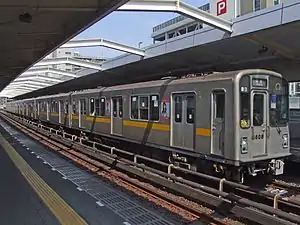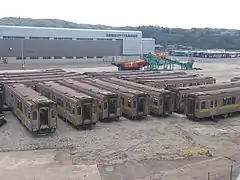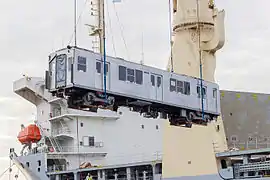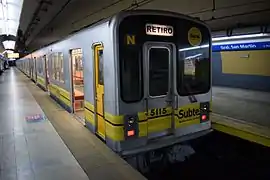Nagoya Municipal Subway 5000 series
The Nagoya Municipal Subway 5000 series (名古屋市交通局5000形) is a rapid transit electric multiple unit (EMU) train type formerly operated by the Transportation Bureau City of Nagoya on the Nagoya Subway Higashiyama Line in Japan from July 1980 until August 2015. Following their withdrawal in Japan, five sets were shipped to Argentina in 2015 for use on Line C of the Buenos Aires Underground.
| Nagoya Municipal Subway 5000 series | |
|---|---|
 Set 5108 in April 2008 | |
| In service | July 1980 – 2015 (Nagoya Subway) 2015–present (Buenos Aires Underground) |
| Constructed | 1980–1990 |
| Refurbished | 2015 (30 vehicles) |
| Scrapped | 2003–2015 |
| Number built | 138 vehicles (23 sets) |
| Number in service | 30 vehicles (5 sets) |
| Number scrapped | 108 vehicles (18 sets) |
| Formation | 6 cars per trainset |
| Capacity | 680 |
| Operator(s) | Transportation Bureau City of Nagoya (1980-2015) Buenos Aires Underground (2015-present) |
| Line(s) served | Higashiyama Line (1980-2015) Line C (2015-present) |
| Specifications | |
| Car body construction | Aluminum alloy[1] |
| Car length | 15.58 m (51 ft 1+3⁄8 in) |
| Width | 2,508 mm (8 ft 2+3⁄4 in) |
| Height | 3.44 m (11 ft 3+3⁄8 in) |
| Floor height | 960 mm (37+3⁄4 in) |
| Doors | 3 pairs per side |
| Maximum speed | 65 km/h (40 mph) |
| Traction system | Chopper control |
| Acceleration | 0.92 m/s2 (2.1 mph/s) |
| Electric system(s) | 600 V DC third rail 1,500 V DC overhead catenary (Buenos Aires) |
| Current collector(s) | Contact shoe Pantograph (Buenos Aires) |
| Braking system(s) | Brake-by-wire hydraulic regenerative brakes |
| Safety system(s) | ATC |
| Track gauge | 1,435 mm (4 ft 8+1⁄2 in) standard gauge |
Formation
The trains were formed as six-car sets, as follows.[1][2]
| Car No. | 1 | 2 | 3 | 4 | 5 | 6 |
|---|---|---|---|---|---|---|
| Designation | Tc1 | M2 | M1 | M1' | M2' | Tc2 |
| Numbering | 5100 | 5200 | 5300 | 5400 | 5500 | 5600 |
| Weight (t) | 22.0 | 24.2 | 22.0 | |||
| Capacity (Total/seated) | 110/38 | 115/44 | 110/38 | |||
One car was designated as a "women-only car" during the morning and evening peak periods on weekdays as a measure to reduce sexual assault during crowded times.[3]
History
The first trains entered service on 1 July 1980.[4] These were the first air-conditioned trains to be used on the Higashiyama Line.[5] A total of 23 sets were built between 1980 and 1990.[6]
Withdrawal and resale
The last remaining 5000 series train in service, set 5114, was withdrawn from the Higashiyama Line following a special final run on 30 August 2015.[7]
In 2015, five 5000 series units (30 vehicles) were shipped to Argentina to be used on Line C of the Buenos Aires Underground. These sets were modified with pantographs to operate from a 1,500 V overhead supply instead of the original 600 V third rail.[8]
 Withdrawn 5000 series cars at the Nihon Sougou Recycle plant in Takaoka, Toyama, awaiting scrapping in May 2013
Withdrawn 5000 series cars at the Nihon Sougou Recycle plant in Takaoka, Toyama, awaiting scrapping in May 2013.jpeg.webp) Withdrawn 5000 series cars at the Osaka Sharyo plant in August 2014 undergoing modifications ahead of shipment to Argentina
Withdrawn 5000 series cars at the Osaka Sharyo plant in August 2014 undergoing modifications ahead of shipment to Argentina A former 5000 series car being unloaded in Argentina in February 2015
A former 5000 series car being unloaded in Argentina in February 2015 Train 5115 on Line C of the Buenos Aires Underground
Train 5115 on Line C of the Buenos Aires Underground
References
- 5000形(東山線)の主要緒元 [5000 series (Higashiyama Line) technical details]. Rolling stock guide (in Japanese). Transportation Bureau City of Nagoya. Retrieved 15 November 2010.
- 私鉄車両編成表 2014 [Private Railway Rolling Stock Formations - 2014] (in Japanese). Japan: Kotsu Shimbunsha. 24 July 2014. p. 95. ISBN 978-4-330-48414-3.
- 女性専用車両 [Women-Only Cars]. Information (in Japanese). Transportation Bureau City of Nagoya. Retrieved 15 November 2010.
- 名市交東山線5000形車輌引退 [Nagoya Subway Higashiyama Line 5000 series to be withdrawn]. Tetsudo Hobidas (in Japanese). Japan: Neko Publishing Co., Ltd. 7 July 2015. Retrieved 7 July 2015.
- 名古屋市営地下鉄:東山線の5000形ラストラン [Last run of Nagoya Municipal Subway Higashiyama Line 5000 series]. Mainichi Shimbun (in Japanese). Japan: The Mainichi Newspapers. Archived from the original on 30 August 2015. Retrieved 31 August 2015.
- Takai, Kunpei (30 June 2014). Morokawa, Hisashi; Hattori, Akihiro (eds.). 全国私鉄超決定版 電車・機関車・気動車1700 [Nationwide Private Railway Ultimate Edition: 1700 EMUs, Locomotives, and DMUs] (in Japanese). Tokyo, Japan: Sekaibunka-sha. p. 172. ISBN 978-4-418-14219-4.
- 名古屋市交通局で5000形車両引退記念イベント [Nagoya Transportation Bureau stages 5000 series retirement event]. Japan Railfan Magazine Online (in Japanese). Japan: Koyusha Co., Ltd. 31 August 2015. Retrieved 31 August 2015.
- "Se embarcan en Japón últimas dos formaciones Nagoya" [Last two Nagoya trainsets leave Japan]. EnElSubte.com (in Spanish). Argentina. 18 May 2015. Retrieved 31 August 2015.
